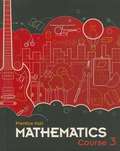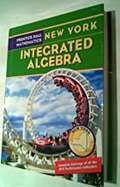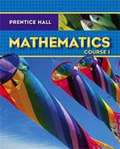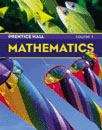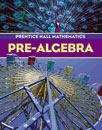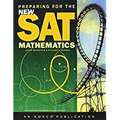- Table View
- List View
Prentice Hall Mathematics Course 1 (Massachusetts)
by Randall I. Charles Mark Illingworth Bonnie Mcnemar Darwin Mills Alma Ramirez Andy ReevesNIMAC-sourced textbook
Prentice Hall Mathematics Course 3
by Randall I. Charles Mark Illingworth Bonnie McnemarNIMAC-sourced textbook
Prentice Hall Mathematics Geometry
by Randall I. Charles Basia Hall Dan Kennedy Art Johnson Laurie E. BassNIMAC-sourced textbook
Prentice Hall Mathematics New York: Integrated Algebra
by Dan S. KennedyTo help you master essential mathematical knowledge and deepen your critical thinking skills, the New York State Board of Education established Learning Standards. Here is an overview of the strands for Number Sense and Operations, Algebra, Measurement, and Statistics and Probability.
Prentice Hall Mathematics, Accelerated Grade 7, Common Core
by Charles McNemar IllingworthNIMAC-sourced textbook
Prentice Hall Mathematics, Algebra 1, California
by Randall I. Charles John A. Dossey Stanley A. SmithNIMAC-sourced textbook
Prentice Hall Mathematics, Algebra Readiness, California
by Randall I. CharlesNIMAC-sourced textbook
Prentice Hall Mathematics, Course 1
by Randall I. Charles Mark Illingworth Bonnie Mcnemar Darwin Mills Alma Ramirez Andy ReevesNIMAC-sourced textbook
Prentice Hall Mathematics, Course 1 (Pennsylvania Edition)
by Randall I. Charles Mark Illingworth Bonnie Mcnemar Darwin Mills Alma Ramirez Andy Reeves Denisse R. ThompsonPrentice Hall Mathematics is designed to enable students tap into the power of mathematics. The text will help them be successful on the tests they take in class and on high-stakes tests required by your state. The practice in each lesson will prepare them for the format as well as for the content of these tests.
Prentice Hall Mathematics, Course 2, Common Core
by Randall I. Charles Mark Illingworth Bonnie McnemarNIMAC-sourced textbook
Prentice Hall Mathematics, Course 3, Oklahoma
by Mark Illingworth Randall Charles Bonnie McNemarNIMAC-sourced textbook
Prentice Hall Mathematics, Pre-Algebra, California
by Randall I. Charles Bonnie Mcnemar Alma RamirezNIMAC-sourced textbook
Prentice Hall Mathematics: Algebra 1 (Connecticut Edition)
by Randall I. Charles Allan E. Bellman Sadie Chavis Bragg Basia Hall Dan Kennedy William G. HandlinNIMAC-sourced textbook
Prentice Hall Mathematics: Algebra 2, Ohio
by Randall I. Charles Allan E. Bellman Sadie Chavis Bragg Basia Hall William G. Handlin Dan Kennedy Sr.NIMAC-sourced textbook
Prentice Hall Mathematics: Course 3, Common Core
by Charles McNemar Ramirez Reeves Illingworth MillsCourse 3 provides a solid foundation for students in Mathematics.Real-World applications to the more abstract algebraic concepts are found throughout the text.
Prentice Hall Mathematics: Geometry
by Randall I. Charles Basia Hall Dan Kennedy Art Johnson Laurie E. BassNIMAC-sourced textbook
Prentice Hall Mathematics: Geometry, Pennsylvania
by Randall I. Charles Basia Hall Dan Kennedy Art Johnson Laurie E. BassNIMAC-sourced textbook
Prentice Hall Mathematics: Pre-Algebra
by Randall I. Charles David M. Davison Marsha S. Landau Leah Mccracken Linda ThompsonThe Problem-Solving Lessons included in Prentice Hall Pre-Algebra progress in depth and sophistication throughout the course. You will learn to combine and compare strategies to solve problems. Throughout the text, a greater focus on the strategy "Write an Equation" helps prepare you for success in algebra.
Preparation for Algebra: Math Advantage
by Harcourt BraceAfter a strategy has been chosen, a good problem solver then decides how to solve the problem. They think about whether using paper or pencil, a calculator, manipulatives, or mental math is the best way to get the answer.
Preparing For The New Sat: Mathematics Student Edition
by Richard J. Andres Joyce BernsteinPreparing for the New SAT: Mathematics Student Edition You are reading this book because you are preparing to take the SAT. Luckily, you have been preparing for the SAT your whole life, whether you knew it or not. Your life experiences, the classes you've taken, the books you've read, and the daily problems you've solved are all a part of what you will bring with you on test day. Nonetheless, the SAT is an important test, and you need to prepare for it in order to get the best score you can. This book will help you get ready by providing lessons on important skills found on the SAT and by modeling SAT questions with complete, step-by-step answer explanations. In addition, you will find many practice problems and four full-length SAT Math Model Exams to rehearse your skills before test day. Using this book will help you be confident and prepared on test day.
Preparing For The Regents Examination: Algebra 2 and Trigonometry
by Ann Davidian Christine T. HealyA review book to accompany Amsco's Algebra Two and Trigonometry.

